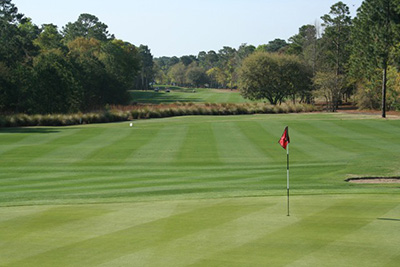As several Grand Strand-area courses have resurfaced their greens in summer 2018 with new turf, the choice among many – including International Club, Diamondback at Woodland Valley, Myrtlewood-PineHills, Sandpiper Bay, Tradition Club and Brick Landing – has been Sunday UltraDwarf Bermudagrass.
But in a time when the impetus behind these greens replacements was finding an improved way for them to withstand South Carolina’s random winter cold snaps, why has Sunday UltraDwarf been the turf of choice?
Sunday UltraDwarf Bermudagrass is a unique greens grass selected for its dense growth canopy, lighter color and reduced seed heads. Genetic stability is a key feature for a successful putting green, and Sunday has proven to be stable for more than three decades.
In the mid-1980s, Cotton Creek Golf Club in south Alabama was looking for an improved greens grass, and developer John Chapman began pulling samples from Cotton Creek’s Dwarf greens that either had a different appearance or a desirable characteristic. He began propagating and maintaining these samples, and found one of them to outperform anything else available on the market at that time.
In the late 1980s, the Cotton Creek Golf Club was sprigged with this experimental grass, thereafter referred to as C-1, and more than a quarter century later these first greens were still performing well and maintaining stability. Sunday is a 2007 selection from these original C-1 greens, which have seen temperatures as low as five degrees and survived multiple days of below freezing temps.
One of the key features of Sunday is its ability to be maintained like a dwarf while delivering UltraDwarf performance. Sunday can be mowed as low as .08 inches for tournament play, with Stimpmeter readings as high as 11. Sunday has a proven track record of success, and is an excellent choice for warm season golf greens.

